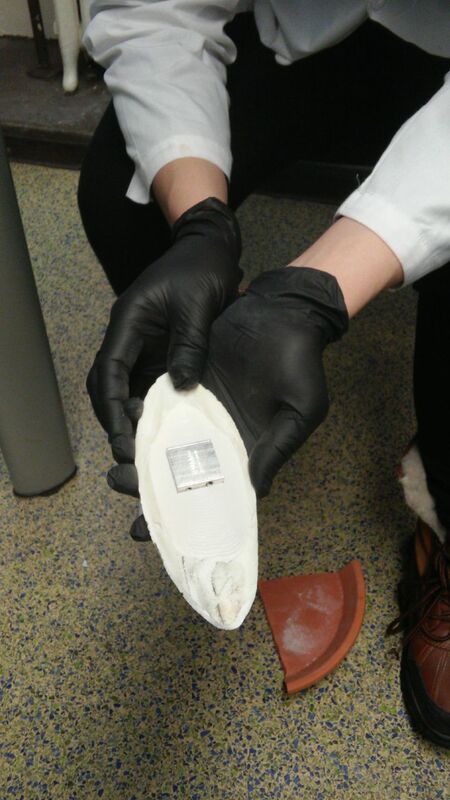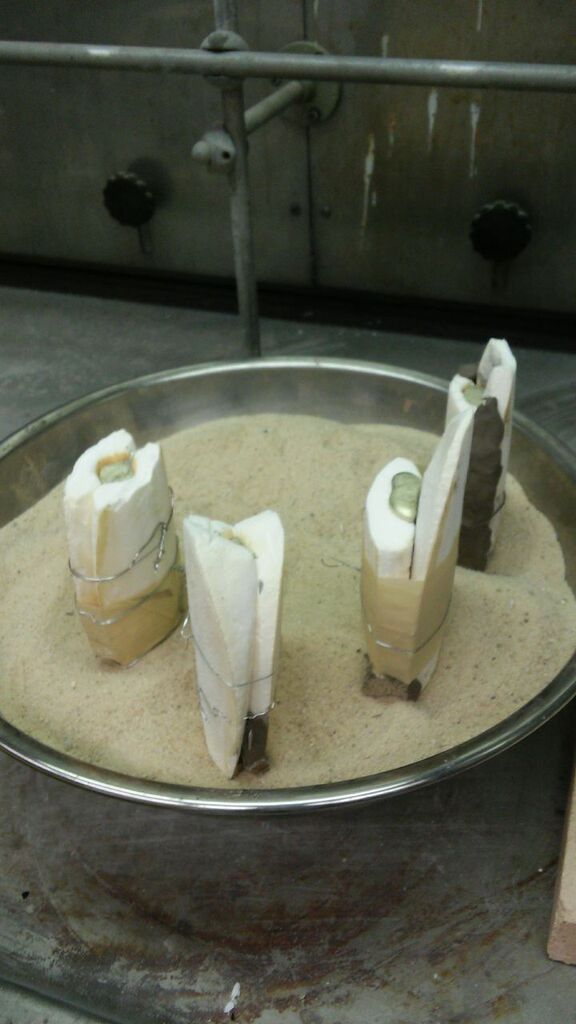DATE AND TIME: March 2, 2015, 10:30 AM
LOCATION:260 Chandler
SUBJECT:Casting with Cuttlefish bone
For Casting with Cuttlefish Bone, I followed recipe 91r for the preparation of the cuttlefish, which calls for smoothing the cuttlefish bone on a mixture of willow ash on top of a piece of terra cotta. Then I followed 145r for the pressing up the cuttlefish, which specifies pressing one half of the cuttlefish bone with something flat, and stepping on it with a foot with the shoe taken off.
Recipes used
title id=”p091r_a2”>Mouler en os de seiche</title>
<ab id=”p091r_b2a”>Garde bien de ne les tenir en lieu humide car ilz sont<lb/>
fort subgects a shumecter Si ta medaille est petite couppe los<lb/>
en deulx puys unis le avec un costeau Et sur une tuile a crochet<lb/>
bien seiche & bien unie & couverte de charbon de saule pulverise<lb/>
frotte & unis les moicties des os Ainsy ilz sabreuvent de ce<lb/>
charbon de saule qui les faict bien despouiller & garde de rien<lb/>
enlever Puys sur un contre os cest a dire un lopin de<lb/>
brique unye de la grandeur de ton os pose ta medaille & puys<lb/>
sur icelle pose los & presse bien avecq quelque aultre piece de<lb/>
la grandeur par dessus Et pour la seconde fois moule le<lb/>
mays plustost ponce dessus du charbon de saule & soufle<lb/>
legerement puys presse co{mm}e au paravant Et il viendra net<lb/>
Si cest pour un manche de cuiller il fault deulx osentiers<lb/>
Tout ouvrage gecte est aigre & subgect a rompre pourceque<lb/>
le metal se dilate au gect & se reserre & condense au marteau<lb/>
Cest pourquoy il fault resuivre la chose gectee avec le ciselet<lb/>
& en ceste sorte le metal se resserre Laisse le ainsy escrouir<lb/>
Si la piece a mouler est de grand relief trasse premierem[{ent}] le<lb/>
moule & le cane avecq un trancheplume pour faire voye a la<lb/>
medaille & puys moule Et si la medaille est a deulx envers</ab>
title id=”p091r_a2”>Molding with cuttlefish bone</title>
<ab id=”p091r_b2a”>Pay attention to keep the bones in a dry place, because they are very prone to dampness. If you have a small medal, divide the bone into two pieces, then smooth the two parts with a knife. And on a dry, smooth rooftile [that has been] pulverized with willow charcoal, rub and polish the two half bones. In this way, the bones soak up the willow charcoal so that the bones will come off cleanly from the cast, and will not stick to it. Then on a fake bone, that is to say a bit of smooth brick of the same width as your bone, place your medal. And then on the medal, put your bone and press it firmly with another stone of the same size. And for a second time, mold it, and instead smooth over the top with willow charcoal and blow slowly, then press as before, and it will cast neatly. If it is for a spoon handle, you need two whole bones. Any work that is cast is brittle and prone to breaking, because the metal swells when cast, and contracts and condenses when hammered. That is why you must retrace with a chisel the cast object and in this way the metal will contract again and let it escrouir. If the piece you have to cast is in high relief, first trace the mold and the hollow with a penknife, to make a clear path for the medal and then cast it. And if the medal has two sides</ab>
<ab id="p145r_b2">
Mais pourceque les doigts ne pressent point uniment on </lb>
car si tu presses par les bords le milieu demeurera creulx </lb>
Commance doncq par le milieu & puys fuis les bords Mays </lb>
pour mieux fayre Mects sur la medaille quelque chose </lb>
platte & unie ou quelque grosse limes quarree & presse avec </lb>
cela car tu presseras esgallement Quelque fois apres </lb>
l avecq un genoul autresfois avec le pied deschausse du </lb>
soulier & fais que lon soict par dessus Ainsy tu lempra </lb>
lempraindras sans le rompre Si du premier coup il nest </lb>
bien moule retournes y plusieurs fois Puys repare </lb>
et unis par les costes tes moicties de los moule Et pour </lb>
le bien couper commance tousjours du plus tendre venant </lb>
a lescaille Et si ta medaille ne sort delle mesme gratte </lb>
Quand tu vouldras gecter asseure & joincts tes deulx </lb>par derriere los qui est raboteux et elle despouillera </lb>
os avecq de petites poinctes de bois & Mays pour mouler
bien net il ny ha que noster sable </ab>
<ab id=”p145v_b2b”>But with fingers you cannot press evenly, because if you press on the edges, the middle will remain hollow. Start therefore with the middle, & then do the edges. But to do it better, put something flat & even on the medal, or some large square file, & press with that; because you will press evenly, sometimes with your knee, other times with your foot with your shoe taken off. & do it from above, so that you impress it without breaking it. If it is not well molded on the first go, do it again several times. Then restore and flatten your halves of molded bone from the sides. And to cut them well, always start from the most tractable part, coming out to the shell. And if your medal does not come out on its own, scratch the rough bone from behind and it will strip. When you want to cast, settle & affix the two bones with little pins of wood & in order to cast neatly, you have only to try it with sand.</ab>
- For the preparation of the Cuttlefish bone, I followed the protocol designated in recipe p091r_b2a, which called for rubbing both halves of the cuttlefish on terracotta and willow charcoal. At the suggestion of Andrew Lacy, I rubbed the bone on the charcoal ash and terra cotta until there was about an inch perimeter around the object we wanted to cast.

Pressing the Mold
- After preparing the cuttlefish bone, I placed my object (a pencil sharpener) on a piece of terra cotta, and placed the cuttlefish bone on top of it, and then placed my heel in the middle of the cuttlefish bone. I pressed down, and surprisingly, the cuttlefish bone sank rather easily onto the terra cotta. Upon flipping over the cuttlefish bone, I found the impression of the pencil sharpener to be very pronounced. This seems to be a good method to press the mold.



Casting with Cuttlefish Bone



- Under the advisement of Andrew Lacy, I bound the imprinted cuttle fish bone with another flattened cuttlefish bone, sawed in half.
- I carved a triangular gate and sawed notches in the sides of the cuttle fish so I could wrap the bones together with a wire.
- I wrapped the bones with a wire, and then as an added security measure, again with tape
- Andrew Lacy heated up the metal, using 2:1 tin to lead ratio, and used the paper test to make sure the metal was not too hot.
- He then poured the metal into the cuttlefish. Luckily nothing spilled out, and the impression of the pencil sharpener came out very well defined.
ASPECTS TO KEEP IN MIND WHEN MAKING FIELD NOTES
- note time
- note (changing) conditions in the room
- note temperature of ingredients to be processed (e.g. cold from fridge, room temperature etc.)
- document materials, equipment, and processes in writing and with photographs
- notes on ingredients and equipment (where did you get them? issues of authenticity)
- note precisely the scales and temperatures you used (please indicate how you interpreted imprecise recipe instruction)
- see also our informal template for recipe reconstructions
